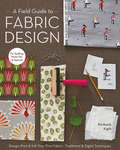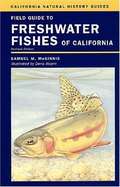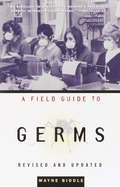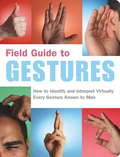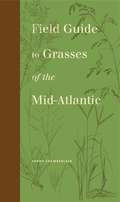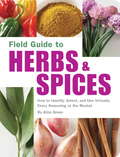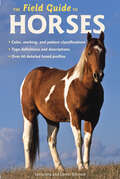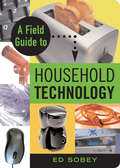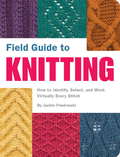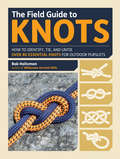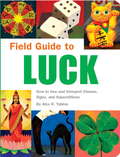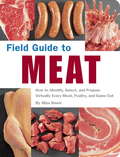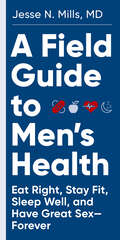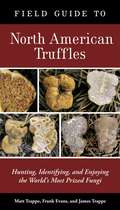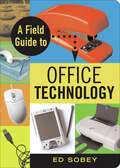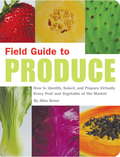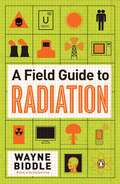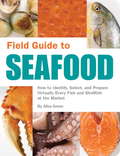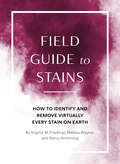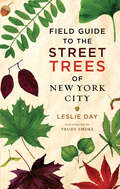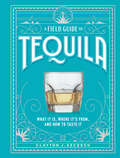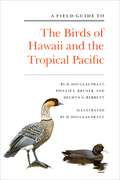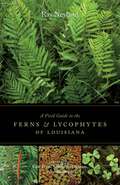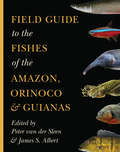- Table View
- List View
A Field Guide to Fabric Design: Design, Print & Sell Your Own Fabric; Traditional & Digital Techniques
by Kimberly KightA comprehensive, step-by-step resource for fabric design and printing—including tips from top designers. If you&’ve ever dreamed of showing your designs on fabric, textile aficionado Kim Kight, of popular blog True Up, is here to teach you how. Comprehensive and refreshingly straightforward, this impressive volume features two main parts. First, the Design and Color section explains the basics with step-by-step tutorials on creating repeating patterns both by hand and on the computer. Next, the Printing section guides you through transferring those designs on fabric—whether it's block printing, screen printing, digital printing or licensing to a fabric company—and how to determine the best method for you. Includes extensive photos and illustrations
Field Guide to Freshwater Fishes of California (Revised Edition)
by Samuel M. McginnisThis book is a field guide to all of California's 130 freshwater fish species, both native and introduced. Revised and updated throughout, the guide features the complete collection of color illustrations of California freshwater fishes available anywhere. These color illustrations, coupled with a set of highly detailed black-and-white drawings, provide a quick and easy method for identifying fish in the field.
A Field Guide to Germs (Newly Revised and Updated): Revised and Updated
by Wayne BiddleFrom the ravages of the Ebola virus in Zaire to outbreaks of pneumonic plague in India and drug-resistant TB in New York City, contagious diseases are fighting back against once-unconquerable modern medicine. Public concern about infectious disease is on the rise as newspapers trumpet the arrivals of new germs and the reemergence of old ones. In A Field Guide to Germs, Pulitzer Prize-winning science writer Wayne Biddle brings readers face to face with nearly one hundred of the best-known (in terms of prevalence, power, historical importance, or even literary interest) of the myriad pathogens that live in and around the human population. Along with physical descriptions of the organisms and the afflictions they cause, the author provides folklore, philosophy, history, and such illustrations as nineteenth century drawings of plague-induced panic, microscopic photographs of HIV and Ebola, and wartime posters warning servicemen against syphilis and gonorrhea. From cholera to chlamydia, TB to HIV, bubonic plague to Lyme disease, rabies to Congo-Crimean encephalitis, anthrax to Zika fever, and back to good old rhinitis (the common cold), A Field Guide to Germs is both a handy reference work to better understand today's headlines and a fascinating look at the astonishing impact of micro-organisms on social and political history.
Field Guide to Gestures
by Melissa Wagner Nancy ArmstrongFinally, a field guide to interpreting more than 100 international gestures, from the wave to the finger, from the shrug to the nod. Here's easy access to the essential information about common (and some not-so-common) gestures you may encounter at home or abroad. Field Guide to Gestures is organized into handy sections for quick reference when time is of the essence and interpretation is everything. If a man bends his torso forward when meeting you, turn to the "Arrival/Departure" chapter to learn more about the bowing gesture. When the woman at the end of the bar flips her hair and looks your way, turn to the "Mating" chapter to learn just what she's trying to say. And if your friend has intertwined his index finger and middle fingers as the night's lottery numbers are being read, go to "No Words Needed" to learn more about the crossed fingers gesture. This practical guide includes more than 100 full-color photographs of the world's most common gestures, plus cross-referenced descriptions throughout, including historical background and common usage. Helpful step-by-step directions and detailed line drawings teach you how to perform each gesture correctly.
Field Guide to Grasses of the Mid-Atlantic (Keystone Books)
by Sarah ChamberlainGrasses are among the most ubiquitous plants on the planet. They inhabit a wide geographic range and are found in a variety of natural habitats. The small parts of the grass flower and specialized terminology, however, can make identifying grasses a challenging endeavor. Sarah Chamberlain’s Field Guide to Grasses of the Mid-Atlantic makes identification simpler for everyone—regardless of their previous botanical knowledge.Featuring an easy-to-use dichotomous key, this is a user-friendly guide to more than 300 types of grasses found from the Blue Ridge Mountains and southern plains to the Appalachians and the Allegheny Plateau. Each major entry contains detailed species diagrams as well as common names, habitats, and distribution. The book’s opening sections outline the parts of grass flowers and describe stem, leaf, and sheath characteristics.With a wealth of illustrations, instructions on how to use the key, and a glossary of terms, Field Guide to Grasses of the Mid-Atlantic is an indispensable reference for naturalists and conservationists, botanists, land management professionals, and students and scholars of mid-Atlantic flora.
Field Guide to Grasses of the Mid-Atlantic (Keystone Books)
by Sarah ChamberlainGrasses are among the most ubiquitous plants on the planet. They inhabit a wide geographic range and are found in a variety of natural habitats. The small parts of the grass flower and specialized terminology, however, can make identifying grasses a challenging endeavor. Sarah Chamberlain’s Field Guide to Grasses of the Mid-Atlantic makes identification simpler for everyone—regardless of their previous botanical knowledge.Featuring an easy-to-use dichotomous key, this is a user-friendly guide to more than 300 types of grasses found from the Blue Ridge Mountains and southern plains to the Appalachians and the Allegheny Plateau. Each major entry contains detailed species diagrams as well as common names, habitats, and distribution. The book’s opening sections outline the parts of grass flowers and describe stem, leaf, and sheath characteristics.With a wealth of illustrations, instructions on how to use the key, and a glossary of terms, Field Guide to Grasses of the Mid-Atlantic is an indispensable reference for naturalists and conservationists, botanists, land management professionals, and students and scholars of mid-Atlantic flora.
Field Guide to Herbs and Spices
by Aliza GreenField Guide to Herbs & Spices will forever change the way you cook. With this practical guide--including full-color photographs of more than 200 different herbs, spices, and spice mixtures--you'll never again be intimidated or confused by the vast array of spices available. Learn to discern the differences between the varieties of basil, the various colors of sesame seeds, the diverse types of sugar and salt, and even how to identify spice pastes like zhoug, harissa, and achiote. Each entry features a basic history of the herb or spice (saffron used to be worth more than gold!), its season (if applicable), selection and preparation tips, a recipe featuring the seasoning, and some suggested flavor pairings. Complete with more than one hundred recipes, Field Guide to Herbs & Spices is a must-have resource for every home cook. Meals will never be the same again!
The Field Guide to Horses
by Samantha Johnson Daniel JohnsonLearn about your favorite equine breeds with this easy-to-use reference on their conformation, colors, and characteristics—from Arabians to Welsh Ponies.Thinking of acquiring a horse? Studying equine breeds and traits? Or simply curious about the magnificent creatures? This book, with profiles of one hundred horse, pony, and draft breeds, is the most comprehensive field guide to horses ever published. Illustrated throughout with fine color photographs, the profiles detail the characteristics and unique aspects of each breed; they also include brief histories and explain distinctions of equine color genetics, markings and patterns, and conformation. Complete, concise, and compact, this field guide is as handy as it is informative—the perfect companion for anyone considering horses.
A Field Guide to Household Technology
by Ed SobeyIllustrating how a fire alarm detects smoke and what the "plasma" is in a plasma screen television, this fascinating handbook explains how everyday household devices function and operate. More than 180 different household technologies are covered, including gadgets unique to apartment buildings and houseboats. Devices are grouped according to their "habitats"--the living room, family room, den, bedroom, kitchen, bathroom, and basement--and feature a detailed description of what the device does and how it works, as well as a photograph for easy identification. With helpful sidebars describing related technical issues, such as why a cheap dimmer switch can interfere with radio reception, this handbook for curious readers provides carefully detailed descriptions and the history behind many of the older household technologies like toasters and faucets to newer technologies like motion detectors, TiVo, and satellite radio.
Field Guide to Knitting
by Jackie PawlowskiAt last, a field guide to identifying and working more than 200 knitting stitches, from stockinette to Orenburg lace! There are so many intriguing ways to knit yarn that it's often tough to pick the right stitch. Help is on the way with Field Guide to Knitting, the stitch dictionary that belongs in every knitting bag. This handy go-to reference book takes a comprehensive look at knit and purl stitches as well as cables, laces, ribs, and edge treatments. Learn to tell k2togs from ssks and to differentiate between ribbed basketweave and basket cable. Each entry reveals the history of the stitch, the best stitch gauge for achieving pattern definition, the garments most suited to the pattern, and more. Complete patterns for executing the stitch (and its variations) are also included. More than 200 full-color photographs make it easy to compare how stitches will look before committing yarn to needles. Whether you just need to know if moss stitch is the same as seed stitch or you're planning a complicated Aran sweater, Field Guide to Knitting has all the answers.
The Field Guide to Knots: How to Identify, Tie, and Untie Over 80 Essential Knots for Outdoor Pursuits
by Bob Holtzman<P>A Fasten-ating Guide to Knots for Every Adventure! The perfect knot can make any job quicker, easier, and safer—whether you need to build a shelter, tether a horse, rappel down a cliff, or moor a boat. In The Field Guide to Knots, veteran outdoorsman Bob Holtzman helps you: <br>Select and tie the right knot for any task <br>Identify and untie existing knots <br>Choose and maintain your rope, and more! <P>With more than 80 time-tested knots and more than 600 color photos, this Field Guide is indispensible for backpackers, climbers, sailors, anglers, hunters, equestrians—and anyone else who’s ever needed to change a sail, reposition a climbing rope, or splice a tent pole!
Field Guide to Luck
by Alys R. YablonTake Control of Your Destiny! From the good luck provided by shamrocks, rabbits's feet, and horseshoes to the misfortune caused by broken mirrors, black cats, and umbrellas opened indoors, our lives are filled with signs and superstitions that guide our destiny and influence our fate. Fortunately, Field Guide to Luck can help you recognize dozens of influential charms, dates, sayings, and symbols wherever you encounter them. Learn what objects are on your side, which practices are best avoided, and where these curious beliefs come from. This indispensable guide reveals their fascinating origins and offers tips for putting them into practice. With Lady Luck on your side and a lucky penny in your pocket, you're sure to lead a charmed life!
Field Guide to Meat
by Aliza GreenAt last, a field guide to identifying and selecting more than 200 different cuts and kinds of meat, from beef and poultry to game and cured meat! An essential resource for every home cook or chef, Field Guide to Meat offers details on virtually every kind of meat available. This practical guide includes more than 200 full-color photographs of cuts of beef, veal, pork, lamb, game, and poultry as well as more than 100 different kinds of cured meats and sausages. Cross-referenced with the photographs are in-depth descriptions of the cuts, including basic history, location in the animal, characteristics, information on how to choose the cut, and flavor affinities. Step-by-step preparation directions tell you whether the item is best marinated, braised, grilled, roasted, or pan-seared. Trips to the butcher's aisle will no longer be intimidating, and you'll never end up with a cut that's too tough for dinner.
A Field Guide to Men's Health: Eat Right, Stay Fit, Sleep Well, and Have Great Sex—Forever
by Jesse MillsDON&’T LEAVE YOUR HEALTH TO CHANCE. Guys, it&’s time to step it up and start taking care of yourselves. Which doesn&’t mean making impossible-to-stick-to changes. Written by one of the leading doctors whose practice is devoted solely to men, A Field Guide to Men&’s Health shows, in the simplest and most effective way possible, how to manage the cornerstones of a healthy life while improving your chances for making it a long one, too. Including: Cardiovascular health—did you know that blood pressure is the most vital of vital signs?Diet and nutrition—follow a formula of 60 percent fruits and vegetables, 30 percent lean proteins, and 10 percent complex carbs for meals, and monitor your waist size to find your ideal weight.Movement, with the best exercise programs for each decade of your life.Sexual health‚ with an owner&’s guide to the penis.Lifestyle, with tips on everything from managing stress—reducing it, embracing it—to the importance of vitamin D.Above all, make these tenets the three pillars of a healthy life: Eat less, move more, sleep more.
Field Guide to North American Truffles: Hunting, Identifying, and Enjoying the World's Most Prized Fungi
by James M. Trappe Frank Evans Matt TrappeThe second most expensive food in the world after saffron, truffles are treasured, coveted, and savored for their mysterious and exotic flavor. This complete field guide shows chefs and fungi aficionados how to forage for and identify the wide variety of truffles that grow in temperate forests throughout North America. Written by expert horticulturalists who have studied, classified, and enjoyed truffles for decades, the FIELD GUIDE TO NORTH AMERICAN TRUFFLES makes these celebrated underground jewels accessible to all. The first full-color illustrated guide to identifying North American truffles by their key features, including profiles of more than 80 species of truffles. Includes more than 80 photographs of rare and hard-to-find truffle species. Features flavor profiles, delectability index, and culinary tips for each species. Perfect size for carrying in a pocket or daypack.Reviews"It'¬?s the first book of its kind, complete with photographs, cross-sectional views of indigenous truffle varieties, guides to seasonal availability, and foraging tips for hundreds of kinds of truffles (both the edible and inedible kinds), as well as tasting notes and cooking tips."-SaveurFrom the Trade Paperback edition.
A Field Guide to Office Technology
by Ed SobeyWith more than 160 entries detailing everything from the junk buried in desk drawers to that mysterious box blinking away in the coat closet, this practical guide navigates through modern office technology. Each entry includes a functional description of a device (what it is and how it works) as well as particulars on who invented it and how its design has evolved over the years. Devices are grouped according to their habitats--in the conference room, hanging from the ceiling, or connected to a computer--to assist in quick and easy identification. Solving office mysteries, such as why telephone keypads have their ones in the upper left corner while calculator keypads place the ones in the lower left corner, this fascinating resource decodes the often confusing technological landscapes of everyday offices.
Field Guide to Produce
by Aliza GreenAt last, a field guide to identifying and selecting more than 200 fruits and vegetables from around the world! The perfect companion for every shopper, Field Guide to Produce offers tips for selecting, storing, and preparing everything from apples to zucchini. When an unfamiliar edible appears on your grocer's shelf, simply flip through the full-color insert until you've found its photograph. Turn to the corresponding page to discover its country of origin, common uses, and season of harvest. This practical guide includes more than 200 full-color photographs of the world's most popular fruits and vegetables, cross-referenced to in-depth descriptions and selection tips. Step-by-step preparation directions tell you whether the item must be peeled, washed, trimmed, or blanched. Grocery shopping--and dinner--will never be the same again!
A Field Guide to Radiation
by Wayne BiddleA comprehensive and accessible guide to understanding how radiation affects our everyday lives Nuclear energy, X-rays, radon, cell phones . . . radiation is part of the way we live on a daily basis, and yet the sources and repercussions of our exposure to it remain mysterious. Now Pulitzer Prize–winning journalist Wayne Biddle offers a first-of-its-kind guide to understanding this fundamental aspect of the universe. From fallout to radiation poisoning, alpha particles to cosmic rays, Biddle illuminates the history, meaning, and health implications of one hundred scientific terms in succinct, witty essays. A Field Guide to Radiation is an essential, engaging handbook that offers wisdom and common sense for today's increasingly nuclear world. .
Field Guide to Seafood
by Aliza GreenAt last, a field guide to identifying and selecting seafood from around the world, including barramundi, lobsterette, wahoo, and more! With the daunting array of fish and shellfish available in today's market, Field Guide to Seafood is a must-have for every seafood consumer! This helpful guide offers a comprehensive look at seafood, covering more than 100 different kinds of fish and shellfish, plus preserved fish, fish sauces, and caviar. Learn to differentiate between Arctic char and salmon or between snow crabs and stone crabs with the in-depth descriptions and full-color photographs. Each entry contains a list of alternate names, characteristics, and suggested preparation, including directions on when to remove or leave the skin. Step-by-step instructions explain how to identify, store, and cook the item. Whether your fish is store-bough or just caught, this guide includes selection tips, suggested recipes, and complementary flavors. You'll never feel overwhelmed by the wide variety of seafood with this handy guide -- don't go shopping without it!
Field Guide to Stains: How to Identify and Remove Virtually Every Stain on Earth (Field Guide)
by Nancy Armstrong Melissa Wagner Virginia M. FriedmanAt last, a field guide to identifying and doing battle with more than 100 stains, from tomato juice to tar, from avocado to urine! Field Guide to Stains is divided into handy sections for easy access to information when time is of the essence: Fruits and Vegetables, Meat and Protein, Household Items, Garage and Yard, and more. Readers will learn more than just removal techniques--details include general descriptions and likely seasons, times, and areas of occurrence. Did you know that a yogurt stain is more likely to occur in January (when New Year's resolutions demand more healthy eating), and that correction fluid stains are more prevalent in April (when the pressure to complete your taxes on time is at a high)? Includes more than 100 full-color photographs of stains, each one cross-referenced to its description and step-by-step removal advice. Quick-reference icons guide the reader to the most essential information in each entry. This guide has a sturdy, stain-proof exterior--making it a necessity for every cubicle, glove compartment, and college dorm. Field Guide to Stains is a must-have for everyone about to venture out into the wild, to the kitchen, or to a night on the town!
Field Guide to Street Trees New York City
by Leslie Day“A handbook for naturalists, sidewalk denizens, apartment dwellers, dog-walkers, and bicycle riders . . . No New Yorker should be without this book.” —Wayne Cahilly, New York Botanical GardenNew York City is an urban oasis with hundreds of thousands of trees, and this guide acquaints residents and visitors alike with fifty species commonly found in the neighborhoods where people live, work, and travel. Beautiful, original drawings of leaves and stunning photographs of bark, fruit, flower, and twig accompany informative descriptions of each species. Detailed maps of the five boroughs identify all of the city’s neighborhoods, and specific addresses pinpoint where to find a good example of each tree species.Trees provide invaluable benefits to the Big Apple: they reduce the rate of respiratory disease, increase property values, cool homes and sidewalks in the summer, block the harsh winds of winter, clean the air, absorb storm water runoff, and provide habitat and food for the city’s wildlife. Bald cypress, swamp oak, silver linden, and all of New York’s most common trees are just a page turn away. Your evening walk will never be the same once you come to know the quiet giants that line the city’s streets.
A Field Guide to Tequila: What It Is, Where It's From, and How to Taste It
by Clayton J. SzczechFor the tequila curious and the tequila connoisseur alike, a complete, illustrated guide to one of the world&’s most popular spirits Time to put away the shot glass—tequila long ago left its spring break clichés in the dust. Today, it is not just a sophisticated global phenomenon but is poised to surpass vodka to become the number one spirit in the U.S. by sales. Which means there&’s no better time for A Field Guide to Tequila, the new bible on this popular spirit. Whether you&’re already an aficionado who likes to slow-sip an artisanal extra-añejo or a margarita lover curious about your favorite drink and what makes it special, A Field Guide to Tequila takes you step by step into everything that makes tequila tequila, from how it came about, to how it&’s made, to how to select, taste, and serve it. Beginning with the origin of every bottle of tequila—the unique blue agave (which is actually much closer, biologically, to a lily than a cactus)—it&’s all here: The life cycle of the blue agave and the complex process of turning it into liquor (hint: There&’s harvesting, steaming, roasting, and—still in use in one legendary distillery—working mules). The five classes of tequila, including the unfortunate myth of blanco&’s inferiority. How to read a tequila label. The seventeen tequila producers to know and brands you need to explore, from giants of the industry like Patrón and José Cuervo to traditionalists, artisans, and innovators, including Tapatío, Siete Leguas, Ocho, G4, and Cava de Oro. The real deal with so many celebrity tequila brands, a phenomenon that started with Bing Crosby. How to set up a tequila tasting. A complete guide to tequila tourism, including dos and don&’ts for visiting the town of Tequila, best times to go, essential stops, and a glossary of Spanish. Oh, and a recipe for a best-ever margarita, plus three other classic tequila cocktails, including the Rolling Stones&’ favorite, the tequila sunrise. With its striking visuals and appealing package, A Field Guide to Tequila is a go-to reference that felicitously also feels like a real gift book—and vice versa.
A Field Guide to the Birds of Hawaii and the Tropical Pacific
by H. Douglas Pratt Phillip L. Bruner Delwyn G. BerrettThis is the first field guide to the identification of the birds of the islands of the tropical Pacific, including the Hawaiian Islands, Fiji, Samoa, Tonga, southeastern Polynesia, and Micronesia. It is intended both as a reference for the expert and as an introduction to birding in the region for the novice. Small enough to be carried afield, it contains much previously unpublished information about behavior, vocalizations, ecology, and distribution. The forty-five color plates depict all plumages of all bird species that breed in the islands, as well as of those that regularly visit them and the surrounding oceans, and of most species believed to be extinct on the islands. Black-and-white figures show many of the rarer visitors.Introductory sections discuss the tropical Pacific as an environment for birds, problems of birding on islands, and bird conservation. Appendixes include maps of the island groups and a thorough bibliography.
A Field Guide to the Ferns and Lycophytes of Louisiana: An American Soldier in Occupied Germany, 1945--1946
by Ray NeylandAny appreciation of Louisiana's beautiful outdoors must include the lush variety of the state's ferns and lycophytes. Their striking diversity in form, color, and size makes identifying the array of species in the region enjoyable for hobbyists and professionals alike.With illustrations and full-color photographs accompanying a complete description of more than sixty varieties, Ray Neyland's A Field Guide to the Ferns and Lycophytes of Louisiana offers an engaging reference for all levels of interest and expertise. Detailed line drawings of plant structures, a glossary of terms, and dichotomous keys make discovering Louisiana's diverse fern family -- the second largest in the country -- both easy and enjoyable.In addition to providing the geographic range, similar species, and traditional and current uses, Neyland's guide follows the spread of ferns and lycophytes into areas of eastern Texas, southern Arkansas, and Mississippi.
Field Guide to the Fishes of the Amazon, Orinoco, and Guianas
by Peter van der Sleen James S. AlbertThe Amazon and Orinoco basins in northern South America are home to the highest concentration of freshwater fish species on earth, with more than 3,000 species allotted to 564 genera. Amazonian fishes include piranhas, electric eels, freshwater stingrays, a myriad of beautiful small-bodied tetras and catfishes, and the largest scaled freshwater fish in the world, the pirarucu. Field Guide to the Fishes of the Amazon, Orinoco, and Guianas provides descriptions and identification keys for all the known genera of fishes that inhabit Greater Amazonia, a vast and still mostly remote region of tropical rainforests, seasonally flooded savannas, and meandering lowland rivers.The guide’s contributors include more than fifty expert scientists. They summarize the current state of knowledge on the taxonomy, species richness, and ecology of these fish groups, and provide references to relevant literature for species-level identifications. This richly illustrated guide contains 700 detailed drawings, 190 color photos, and 500 distribution maps, which cover all genera. An extensive and illustrated glossary helps readers with the identification keys.The first complete overview of the fish diversity in the Amazon, Orinoco, and Guianas, this comprehensive guide is essential for anyone interested in the freshwater life inhabiting this part of the world.First complete overview of the fish diversity in the Amazon and Orinoco basinsContributors include more than fifty expertsIdentification keys and distribution maps for all genera190 stunning color photos 700 detailed line drawingsExtensive and illustrated glossary
